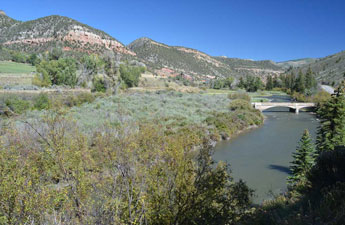
This is a guest blog previously published by the Vail Daily.
Editor’s note: The author wrote this column on behalf of Eagle River Watershed Council.
Colorado is blessed with many rivers that flow from melting winter snows to the sea crossing nearly a third of the country. These rivers support the significant recreation economy of Colorado’s mountain communities. Fishing, rafting, kayaking, skiing and the many golf courses all depend on sustainable water flowing in these rivers systems. These same rivers also support many thriving ranches and farms along their journey.
The rivers themselves are the living heart of the most important wildlife habitat in the West, where water is often the single most precious resource. These vibrant ribbons of life are also at the heart of why so many of us love and live in the West.
Eagle County hosts two of these great rivers, the Eagle and Colorado, as they flow west toward Utah and the great canyons of the Colorado Plateau. The watershed of the Eagle lies almost entirely within the county’s borders, something unique in Colorado. The Eagle River Watershed Council advocates for the health and conservation of the Upper Colorado and Eagle River basins in the county through research, education and projects.
American Rivers, a national river conservation organization, has developed a program of Blue Trails to help people connect with special rivers. The Blue Trail program works with local partners, like the Watershed Council, to link communities and their rivers through access, recreation and informed stewardship. It also helps foster a sense of “ownership” for the rivers and the lands through which they flow and support. Local citizens are now working to develop Blue Trails on the Eagle and Upper Colorado from State Bridge to Dotsero.
People in Eagle County have long cared for these rivers. The efforts to clean up the Eagle Mine Superfund site, the fight for the river and wilderness in the Homestake II case and the earlier efforts to keep Denver Water’s Eagle-Piney project at bay and I-70 from destroying the Gore Creek Valley above East Vail are examples of the Eagle Valley’s determination to protect its rivers.
Today the Eagle Valley is home to a new generation who are the heirs of these past efforts on behalf of the Eagle and Colorado rivers. The Eagle River Blue Trail project is working with groups like the Eagle River Watershed Council, Eagle County, municipalities, outfitters and recreation organizations to strengthen the community ties to the rivers.
At the heart of the Eagle River Blue Trail will be a tremendous source of information about the rivers, access and recreation opportunities. Eagle County, the Eagle Valley Land Trust and others have acquired new land parcels along both rivers, opening up greater opportunities to enjoy the Eagle and Colorado.
These parcels join many other access points and lands. The Eagle River Blue Trail project will provide a single source for all of these places, from Tennessee Pass and Rancho Del Rio down to Dotsero where the two rivers join.
American Rivers will continue to partner with the community and local organizations to promote, preserve and protect Eagle County rivers. Join the Eagle River Watershed Council and American Rivers on Wednesday, March 19, at 6 p.m. in the Eagle Library for a Watershed Wednesday program on the Eagle River Blue Trail project. We want to hear from you: your thoughts, ideas and concerns. The Eagle and Colorado Rivers face new challenges, and a new generation of residents and visitors alike who care for them. Get to know these rivers better and help make a Blue Trail that can serve the Eagle and Colorado into the future.
Ken Neubecker is the Eagle River Blue Trails coordinator for American Rivers. Ken served as the president of the board of directors for the Eagle River Watershed Council and remains closely tied with the organization. Contact Ken at ken.neubecker@americanrivers.org. The Eagle River Watershed Council has a mission to advocate for the health and conservation of the Upper Colorado and Eagle River basins through research, education, and projects. Learn more at erwc.org.
